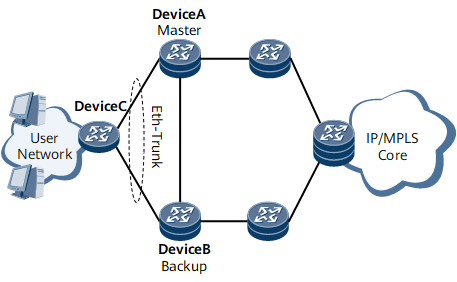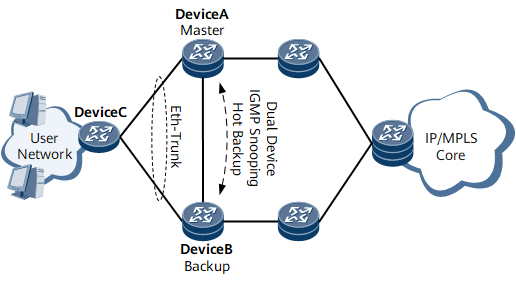Dual-Device IGMP Snooping Hot Backup
Networking Description
Dual-device IGMP snooping hot backup enables the master device and the backup device synchronously generate multicast entries in real time. The IGMP protocol packets are synchronized from the master device to the backup device, so that the same multicast forwarding table entries can be generated on the backup device. After you deploy dual-device ARP hot backup, the new master device forwards downlink traffic without needing to relearn multicast forwarding table entries by IGMP snooping. Dual-device IGMP snooping hot backup ensures downlink traffic continuity.
Figure 1 shows a typical network topology in which an Eth—Trunk group is deployed. In the topology, Device A is a master device, and Device B is a backup device. In normal circumstances, Device A forwards both uplink and downlink traffic. If Device A or the link between Device A and the switch fails, a master/backup Eth—Trunk link switchover is triggered to switch Device B to the Master state. Device B needs to advertise a network segment route to a device on the network side to direct downlink traffic from the network side to Device B. If Device B has not generated multicast forwarding entries directing traffic to the user side, the downlink traffic is interrupted. Device B forwards the downlink traffic only after it generates forwarding entries directing traffic to the user side.
Feature Deployment
To prevent downlink traffic from being interrupted because Device B does not generate multicast forwarding entries directing traffic to the user side, deploy dual-device IGMP snooping hot backup on Device A and Device B, as shown in Figure 2.
After the deployment, Device A and Device B generate the same multicast forwarding entries at the same time. If a master/backup Eth-Trunk link switchover occurs, Device B forwards downlink traffic based on the generated multicast forwarding entries without needing to generate the entries directing traffic to the user side.

